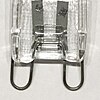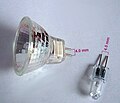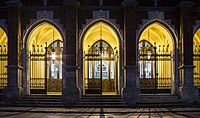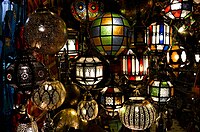Bi-pin lamp base
A bipin or bi-pin (sometimes referred to as two-pin, bipin cap or bipin socket) is a type of
Some sockets have pins placed closer together, preventing the low-power bulbs they use from being replaced by bulbs that are too high power, which may generate excessive heat and possibly cause a fire. These are sometimes called "mini-bipin". Where the terminals of the lamp are bent back onto the sides of the base of the bulb, this forms a wedge base, often used in small bulbs for automotive lighting.
The bi-pin base was invented by
Types
| Illustration | Designation | IEC 60061-1 sheet | Pin | Usage | |
|---|---|---|---|---|---|
| Pitch | Diameter | ||||

|
G4 | 7004-72-3 | 4.0 mm | 0.65–0.75 mm | Small halogen quartz capsules of 5/10/20 watt and 6/12 volt AC and DC. |
| GU4 | 7004-108-2 | 4.0 mm | 0.95–1.05 mm | MR11 and MR8
| |
| GY4 | 7004-72A-1 | 4.0 mm | 0.65–0.75 mm | ||
| GZ4 | 7004-67-3 | 4.0 mm | 0.95–1.05 mm | MR11 and MR8 | |
| G5 | 7004-52-7 | 5 mm | T4 and T5 fluorescent tubes | ||

|
G5.3 | 7004-73-2 | 5.33 mm | 1.47–1.65 mm | |
| G5.3-4.8 | 7004-126-1 | ||||

|
GU5.3 | 7004-109-2 | 5.33 mm | 1.45-1.6 mm | |
| GX5.3 | 7004-73A-2 | 5.33 mm | 1.45–1.6 mm | Round pins. MR16 and other small halogens of 20/35/50 watt and 12/24 volt.
| |

|
GY5.3 | 7004-73B-2 | 5.33 mm | — | Flat pins |

|
G6.35 | 7004-59-6 | 6.35 mm | 0.95–1.05 mm | |
| GX6.35 | 7004-59-6 | 6.35 mm | 0.95–1.05 mm | ||
| GY6.35 | 7004-59-6 | 6.35 mm | 1.2–1.3 mm | Halogen various wattage (e.g. 50 W/100 W), various voltage (e.g. 12/24 V). Common for task lighting, landscape lighting. | |
| GZ6.35 | 7004-59A-3 | 6.35 mm | 0.95–1.05 mm | projector bulb | |
| G8 | — | 8.0 mm | 1.0 mm | Halogen 35–100 W 120-240 V | |
| GY8.6 | — | 8.0 mm | 1.25 mm | Halogen up to 100 W, 120 V | |

|
G9 | 7004-129-3 | 9.0 mm | Halogen 120 V (US) / 230 V (EU), also used for LED lamps. | |
| G9.5 | 7004-70-2 | 9.5 mm | 3.10–3.25 mm | Common for theatre use, several variants | |

|
GU10 | 7004-121-2 | 10 mm | 5 mm | Twist-lock 120/230-volt MR16 halogen lighting of 35/50 watt, since the mid-2000s. Also used for compact fluorescents and LED lamps. |
| GZ10 | 7004-120-1 | 10 mm | Twist-lock 120/230- dichroic reflector. GZ10 fixtures can use GU10 bulbs, but not vice versa.
| ||
| G12 | 7004-63-2 | 12.0 mm | 2.35 mm | Used in theatre and single-end metal halide lamps. | |
| G13 | 7004-51-10 | 0.50 in (12.7 mm) | 0.093 in (2.35 mm) | Common T8, T10 and T12 fluorescent tubes. | |
| GX16d | "Mogul End Prong", common for theatre PAR lamps. | ||||
| G23 | 7004-69-1 | 23 mm | 2 mm | ||

|
GU24 | 7004-78-5 | 24 mm | Twist-lock for self-ballasted compact fluorescents, since the 2000s. | |

|
G38 | 7004-76-1 | 38 mm | 11.1 mm | Mostly used for high-power theatre lamps. |

|
GX53 | 7004-142-2 | 53 mm | Twist-lock for cabinet compact fluorescents and LED lamps, since the 2000s.
| |
| GX70 | — | 70 mm | Twist-lock for puck-shaped compact fluorescents or LED lamps. | ||
The suffix after the G indicates the pin spread; the G dates to the use of Glass for the original bulbs. GU usually also indicates that the lamp provides a mechanism for physical support by the
A
There are also double-ended halogen and fluorescent tubes with one pin at each end, and high-output fluorescents with recessed or shrouded contacts, which are not covered here.
-
Halogen lamps with GU4 (left) and G4 (right) bases
-
Halogen lamp with G6.35 base
-
Metal halide lampwith G8.5 base
-
Halogen lamp with G9 looped-pin base
-
Halogen lamp with GU10 twist-lock base
See also
References
- ^ *U.S. patent 543,280, incandescent electric lamp
- ^ Simon Brammer (28 March 2014). "Converting to LED lights: everything you need to know". The Guardian. Retrieved 20 November 2018.
- ^ "index". Osram.com. 2012-03-09. Archived from the original on April 29, 2011. Retrieved 2012-04-25.
External links
 Media related to Bipin at Wikimedia Commons
Media related to Bipin at Wikimedia Commons- Cross-reference for EU/US








